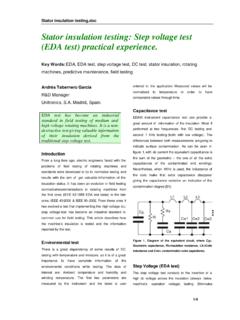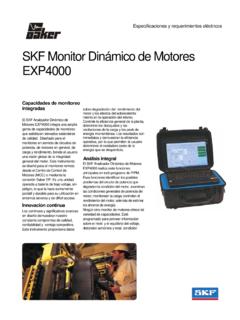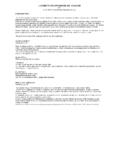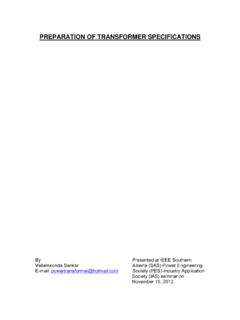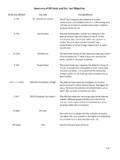Transcription of The Megger guide to insulating oil dielectric …
1 The word Megger is a registered trademarkThe Megger guide to insulating oil dielectric breakdown testing4 Contents1. Introduction ..32. What are the methods for testing oil? ..33. What is oil dielectric breakdown voltage testing ? ..44. Who needs to perform dielectric breakdown voltage tests? ..45. Which types of insulating oil can be tested? ..46. Why, when and how often is oil testing performed? ..67. What are the test standards and their differences? ..6 ASTM standards (USA) ..8 IEC standards (international) ..98. How should an oil sample be taken? ..109. Preparing the test vessel ..1210. Why measure oil sample temperature? ..1311. How do I know whether my test results are valid? ..1312. How do I know if my fluid has passed the test? ..14 USA ASTM and IEEE standards ..14 International IEC standards ..1513. Can new oil fail a dielectric breakdown test? ..1614. Can I verify my test instrument performance? ..1715. How do oil test sets detect dielectric breakdown ?
2 17 testing silicone oil ..1816. Choosing an oil dielectric breakdown voltage test set ..18 On-site versus laboratory testing ..18 General instrument selection considerations ..18 Selection considerations specific to laboratory instruments ..24 Selection considerations specific to portable instruments ..2517. Megger OTS range summary ..27 AcknowledgmentsMegger gratefully acknowledges the support of John Noakhes of TJ/H2b Analytical Services for his help in compiling this IntroductionOils that combine a high flashpoint with high dielectric strength have long been used as an insulating medium in transformers, switchgear and other electrical apparatus. To ensure that the dielectric strength of the oil does not deteriorate however, proper maintenance is essential, and the basis of proper maintenance is over 100 years, Megger has been a world leader in the development and manufacture of test equipment for electrical power applications.
3 The famous Megger trademark was first registered in 1903, and jealously guarded by the company. Megger s experience in the design and production of oil test sets also reaches back to the early 20th century, when pioneering equipment was produced by Foster Transformers, a company that became part of Megger Group in , all of Megger s oil test set design, development and manufacture is carried out at the company s manufacturing facility in Dover, What are the methods testing oil?For in-service equipment in particular, there are many test techniques for evaluating the condition of the insulating oil. If the technique of dissolved gas analysis is excluded, oil tests can be divided into two basic groups. The first group includes tests that are concerned with the immediate condition and acceptability of the insulation in an item of electrical equipment. This group includes dielectric breakdown voltage testing as well as moisture measurement by the Karl Fischer (KF) method, and determination of insulation condition by measuring the dielectric dissipation Megger OTS range of dielectric breakdown voltage test setsThe Megger KF range of moisture content test sets6 The second group includes tests that look at the degree of degradation and aging of the equipment s insulation system.
4 These tests include interfacial tension, acidity (neutralisation value), resistivity and visual determination of colour and appearance of the insulating oil colour specimensThe darker the colour the more contaminants presentGood .. Fair ..BadWhile all of these tests are useful in particular circumstances, the most convenient and most universally applicable is dielectric breakdown voltage testing , which is why it has been selected as the subject of this technical What is oil dielectric breakdown voltage testing ?Put simply, a dielectric breakdown voltage test is a measure of the electrical stress that an insulating oil can withstand without breakdown . The test is performed using a test vessel that has two electrodes mounted in it, with a gap between them. A sample of the oil to be tested is put into the vessel and an ac voltage is applied to the electrodes. This voltage is increased until the oil breaks down that is, until a spark passes between the electrodes.
5 The test voltage is then immediately turned off. The voltage at which breakdown occurred is the test result, and is typically evaluated by comparing it with guidelines set out in various standards, or in the oil manufacturer s exact method of performing the test is determined by the standard that is being used, as will be explained later. The standard typically defines parameters such as the size and shape of the electrodes, the gap between them, the rate at which the test voltage is increased, how many times the test is repeated and whether or not the oil is stirred during the Who needs to perform dielectric breakdown voltage tests?There are many types of organisation that benefit from carrying out tests on transformer oil. These include: Utility contractors (principally in substations) Utility companies (principally in power stations) Rail companies (locomotive HV step-down transformers and switchgear) Oil test laboratories (providing testing services) Transformer and switchgear manufacturers (quality control of oil) Oil companies ( testing new oil during manufacture)5.
6 Which types of insulating oil can be tested?While the generic term oil is almost universally used to describe insulating fluids, there are currently five different types of insulating fluid in common use. These are: Mineral oil High molecular weight hydrocarbon (HMWH) fluids Silicone fluids Synthetic ester fluids Natural ester (vegetable oil) fluids 7 All of these oil types can be tested for dielectric breakdown voltage and tested with Megger OTS range test oil is the most common insulating fluid and has been in use since the late 19th century. There are many mineral oil filled transformers that have been in continuous use for more than 50 years. Mineral oils are refined from either naphthenic crude or more recently, from paraffinic , silicon, synthetic ester and natural ester fluids are more recent developments and are often preferred because they are much less flammable than mineral oil. ASTM D5222 specifies that for insulating fluids to qualify as less flammable they must have a fire point of at least 300 five fluids differ significantly in the way they behave in the presence of moisture.
7 Mineral oil is the least satisfactory, and even small amounts of water significantly reduce its breakdown voltage. Silicone fluid is also quickly affected by small amounts of moisture, whereas ester fluids behave very well in the presence of moisture and can typically maintain a breakdown voltage of greater than 30 kV with more than 400 ppm water content. This is one of the reasons that esters last much longer in table is not exhaustive, but does give a good indication of the types of insulating fluid that are used in various applications. It also shows which types of fluid can be tested with the Megger OTS range of dielectric breakdown voltage test sets. EquipmentFluid TypeExample/Sub-typeCan be tested with Megger OTS range?CapacitorsSynthetic aromatic hydrocarbonsPXEYe sAromatic estersVarious typesYe sMedium and high voltage cablesNewSynthetic hydrocarbonsPolybutenesYe sOldMineral oilVarious typesYe sBushingsMineral oilVarious typesYe sOil filled circuit breakersMineral oilVarious typesYe sTransformersMineral oilShell Diala AXYe sPerflurocarbon (PFC)3M PF-5060Ye sLow flammability fluidsHigh molecular weight (HMW) oilVarious typesYe sSiliconeDow Corning 561Ye sSynthetic hydrocarbonsPolyalohaolefins (PAOs)Ye sSynthetic polyol estersEnvirotemp 200Ye sVegetable oils - natural esterEnvirotemp FR3Ye sHydroflurocarbonVertrel VXYe sOld fluidsPCBs - Polychlorinated biphenylsAskarel Pyranol Phenochlor No - Harzardous - requires special handlingTetrachloroethylene/perchloroeth ylene (PCE)Askarel (contained 50%)Wecosol No - Harzardous - requires special handlingGasesSulphur HexafluorideSF6 NoOld gasesFreon R-113 VapotransNoLTC (Load Tap Changers)
8 Mineral oilVarious typesYe s86. Why, when and how often is oil testing performed? Why and when?The dielectric breakdown voltage test is a relatively quick and easy way of determining the amount of contamination in insulating oil. Usually the contaminant is water, but it can also be conductive particles, dirt, debris, insulating particles and the by-products of oxidation and aging of the in-service equipment, the dielectric breakdown voltage test offers a useful and convenient way to detect moisture and other contamination in the oil before it leads to a catastrophic failure. The information gained from the test can also be used as an aid to: Predicting the remaining life of a transformer Enhancing operational safety Preventing equipment fires Maintaining reliabilityDielectric breakdown voltage testing is also carried out on new oil before it is used to fill equipment, and as part of the acceptance testing for deliveries of new and reprocessed How often?
9 dielectric breakdown voltage testing is an important element in the maintenance programme of any item of oil-insulated electrical equipment. However, to get the maximum benefit from this type of testing , Megger strongly recommends that the oil is tested at least once a year and preferably twice a year. The results should be recorded, as trending the data will make it easier to identify sudden or unexpected changes. If a sudden change in the results is found, the transformer can be inspected for leaks, the oil level can be checked and the water content of the oil evaluated. If contamination is confirmed, it will often be possible to dry and filter the oil, thereby reconditioning it rather than having to replace it with expensive new What are the test standards and their differences? There are many test standards for insulating liquids, but they are derivatives of three main standards. Two of these are from ASTM International (USA) and the other is from the IEC (Europe).
10 These main standards are: ASTM D877 Standard Test Method for dielectric breakdown Voltage of insulating Liquids Using Disk Electrodes. ASTM D1816 Standard Test Method for dielectric breakdown Voltage of insulating Oils of Petroleum Origin Using VDE Electrodes. IEC 60156 insulating Liquids Determination of the breakdown voltage at power frequencies Test method. There is also a Japanese standard not based on these ASTM or IEC following table is not exhaustive, but it shows the main differences between the ASTM and IEC 25 30 35 40 45 50 1 2 3 4 5 6 7 8 BDV (kV) Period between tests ( years) 9 StandardsASTM D1816 ASTM D 877 IEC 60156 Procedure AProcedure BOriginUSAUSAUSAE uropeElectrodesShapeGap size2 mm or 1 mm* mmOil sample stirringImpelleryesnot stirrednot stirredoptionalMagnetic beadno optionoptionalLaboratory test temperatureLiquid At ambient - mustrecord 20 - 30 C must record temperature as collected and when tested 20 - 30 C must record temperature as collected and when tested15 - 25 C for referee testsAmbient20 - 30 CMust record Must record Within 5 C of oil sampleOutside test temperatureLiquid At ambient - must recordMust recordMust record15 - 25 CAmbientReferee tests 20 - 30 C Must record Must record Within 5 C of oil sampleTest voltageRise kV/s3 kV/s3 kV/s2 kV/sFrequency45 - 6545 - 6545 - 6545 - 62 BreakdownsDefinition<100 V<100 V<100 V4 mA for 5 msNumber in sequence5**5*1 - 5 different samples6 Time between breakdown1 to min1 minn/a2 minTest voltage switch off time following break-downNormal

